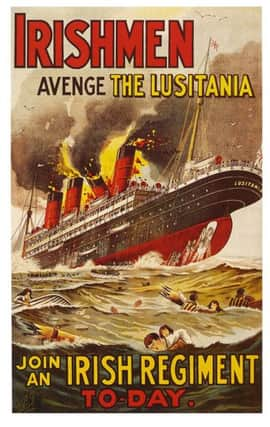‘Lisburn’s lost’ in Lusitania


It was one of the most shocking civilian atrocities of the Great War (1914-1918).
Carrying over 1,900 passengers and crew and bound for Liverpool, the Lusitania was torpedoed and sunk by a German U-Boat (submarine) off the coast of Co. Cork, Ireland.
Advertisement
Hide AdAdvertisement
Hide AdPrior to the ships departure from New York in early May the German Embassy had placed adverts in the US press warning that British ships were legitimate targets.
Over 1,190 passengers drowned and the survivors were taken ashore at Queenstown Harbour (Cobh), Co. Cork.
A total of 150 of the victims were buried in mass graves outside the town.
The sinking of the Lusitania sparked international outrage, yet the Germans defended the attack on the grounds that it was carrying tons of munitions, bound for the Allied war effort.
Advertisement
Hide AdAdvertisement
Hide AdAs the Lisburn Standard reported, Mrs Margaret Hastings, a widow, had perished, and her body had been quickly buried in a mass grave in Queenstown, along with 65 other coffins.
She had been returning to the town after emigrating to New York to provide for her children who lived with relatives on Market Street, Lisburn.
The Standard also relayed the ‘sad homecoming’ of Mrs Jeanette Mitchell, Ballylesson. Arriving on a late-night train to Lisburn Station a few days after the incident, she brought home the body of her drowned husband, a former employee at the Island Spinning Company and a relative of Canon Pounden, Rector of Lisburn Cathedral, for burial in Drumbo. Their young nine-month old son Walter Mitchell Jr was buried in a mass grave at Cobh. Mrs Mitchell’s brother John Moore was also on board, and survived by ‘clutching to the keel of an upturned boat’.
The story of the sinking of the Lusitania as well as other events in 1915, including the Gallipoli campaign, are told in the Irish Linen Centre & Lisburn Museum’s updated exhibition ‘Lisburn, 1912-1914’. Free Entry.